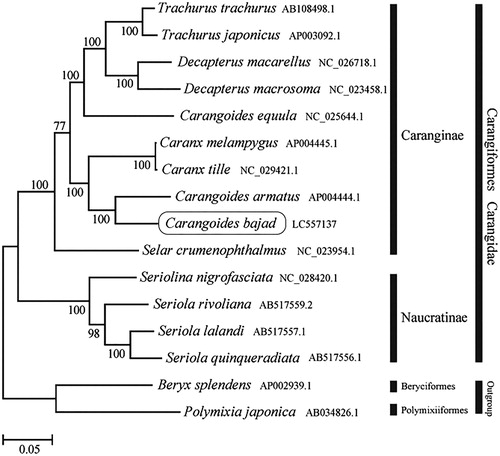Abstract
The complete mitochondrial genome of the orange-spotted trevally, Carangoides bajad, which belongs to the family Carangidae was determined. The complete mitochondrial genome has a length of 16,556 bp and consists of 13 protein-coding genes, 22 tRNA genes, two rRNA genes, and a control region. Carangoides bajad has a mitochondrial gene arrangement that is typical of vertebrates. Phylogenetic analysis using mitochondrial genomes of 13 related species revealed that C. bajad formed a well-supported monophyletic group with the other Carangidae species.
The orange-spotted trevally, Carangoides bajad, (Perciformes, Carangidae), is an inshore marine fish that inhabits the Indo-Wet Pacific (Smith-Vaniz Citation1984). Carangids are an important food source in the commercial fisheries industry in Southeast Asia (Mohsin and Ambak Citation1996). The C. bajad is listed as Least Concern in IUCN Red List due to fishing and harvesting aquatic resources (Smith-Vaniz and Williams Citation2016). In this study, we determined the complete mitochondrial genome sequence of C. bajad and compared the sequence with those of other species of Carangidae.
The C. bajad specimen was collected from Ho Chi Minh City, Vietnam (10.53 N, 106.45 W). Total genomic DNA was extracted from the specimen tissue, which has been deposited at the National Marine Biodiversity Institute of Korea (Voucher No. MABIK0002416). The mitogenome was sequenced using Illumina Hiseq 4000 sequencing platform (Illumina, San Diego, CA) and assembled with SOAPdenovo at Macrogen Inc. (Korea). The complete mitochondrial genome was annotated using MacClade ver. 4.08 (http://macclade.org/macclade) (Maddison and Maddison Citation2005) and tRNAscan-SE ver. 2.0 (http://lowelab.ucsc.edu/tRNAscan-SE) (Lowe and Chan Citation2016).
The complete mitochondrial genome of C. bajad (GenBank accession no. LC557137) is 16,556 bp in length and includes 13 protein-coding genes, 22 tRNA genes, 2 rRNA genes, and a control region. The overall base composition is 28.35% A, 29.77% C, 15.83% G, and 26.05% T. All tRNA genes can fold into a typical cloverleaf structure, with lengths ranging from 67 to 75 bp. The 12S rRNA (950 bp) and 16S rRNA genes (1719 bp) are located between tRNAPhe and tRNAVal and between tRNAVal and tRNALeu(UUR), respectively. Of the 13 protein-coding genes, 12 start with ATG; the exception being COI, which starts with GTG. The stop codon of the protein-coding genes is TAA (ND1, COI, ATP8, ND4L, ND5, and ND6), T— (ND2, COII, ND3, ND4, and Cytb) and TA– (ATP6 and COIII). A control region (860 bp) is located between tRNAPro and tRNAPhe.
The phylogenetic trees were constructed by the maximum-likelihood method with 1000 replicates using MEGA 7.0 software (MEGA, Philadelphia, PA) (Kumar et al. Citation2016). We compared the phylogenetic trees of the newly sequenced genome and 13 other complete Carangidae (Caranginae and Naucratinae) species mitochondrial genome sequences acquired from the National Center for Biotechnology Information. We confirmed that C. bajad formed a monophyletic group with the other Caranginae species (). This mitochondrial genome could be helpful for developing a conservation strategy.
Disclosure statement
The authors report no conflict of interests. The authors alone are responsible for the content and writing of the paper.
Data availability statement
The data that support the findings of this study are openly available in the DNA Data Bank of Japan (accession no. LC557137) at https://www.ddbj.nig.ac.jp.
Additional information
Funding
References
- Kumar S, Stecher G, Tamura K. 2016. MEGA7: molecular evolutionary genetics analysis version 7.0 for bigger datasets. Mol Biol Evol. 33(7):1870–1874.
- Lowe TM, Chan PP. 2016. tRNAscan-SE On-line: integrating search and context for analysis of transfer RNA genes. Nucleic Acids Res. 44(W1):W54–W57.
- Maddison DR, Maddison WP. 2005. MacClade 4: analysis of phylogeny and character evolution. Ver. 4.08. Sunderland (MA): Sinauer Associates.
- Mohsin AKM, Ambak MA. 1996. Marine fishes and fisheries of Malaysia and neighbouring countries. Malaysia: Universiti Pertanian Malaysia Press; 744 p.
- Smith-Vaniz WF. 1984. Carangidae. In: Fischer W, Bianchi G, editors. FAO species identification sheets for fishery purposes. Western Indian Ocean fishing area 51. Vol. 1. Rome: FAO.
- Smith-Vaniz WF, Williams I. 2016. Carangoides bajad (errata version published in 2017). The IUCN Red List of Threatened Species. e.T46080857A115391273. 2016. https://dx.doi.org/10.2305/IUCN.UK.2016-3.RLTS.T46080857A46664509.en.

